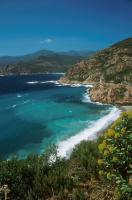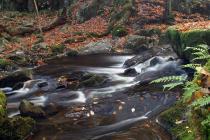The polarizing filter is one of the most useful filters for outdoor photography. It should really be in every serious photographer's camera bag.
Polarizing filters exist for most camera types, from medium format to digital point and shoot cameras. Autofocus SLRs (like the ones I use) need circular polarizers. In these, the front side rotates which enables the user to see the effect gradually appear in the viewfinder.
Polarizing filter effects
The polarizing filter has one main effect: it eliminates reflection from non metal surfaces. It is effective on:
-
 Skies
Skies
By eliminating the reflection of light on the tiny water droplets present in the atmosphere the polarizer brings more saturated and slighly darker skies. However this does not work from any angle. You will generally be able to assess the effect visually, especially with a SLR camera, but keep in mind that it works best with the sun at 90° from your position. With the sun in front, a polarizing filter will have no effect. -
Water and reflective surfaces
By eliminating reflections, the polarizing filter will tend to make water and other reflective surfaces more transparent. The effect will also vary depending on the angle to the reflective surface. If you place your camera very low above a river, the effect will be very limited. If you shoot from a bridge above it, the water will look totally transparent. -
Colors
The polarizing filter also reduces reflection from other surfaces such as foliage and thus makes their colors look more intense. It also tends to make shadow areas darker. -
Light absorption
The main side-effect of the polarizing filter is that it absorbs 1.5 stop of light. Thus if you shoot at 1/180th of a second and then add the filter, you will find yourself at 1/60th of a second. This happens whatever the orientation for a circular polarizer. This does not make a polarizing filter quite usable in low light or indoors but has some interesting uses as pointed out below.
Choosing a polarizing filter

On top a classic BW polarizer
below a wide angle HOYA polarizer.
Notice the difference in thickness
On SLR cameras, the usual polarizing filter has to be screwed onto the lens. Of course, you need to pay attention to the diameter of the ring. It is generally mentioned on the lens itself.
The wider the lens, the more expensive the polarizer. I never purchased one for my 82mm wide Sigma 20 because of its price.
Cokin and Singh Ray both proposer filters that fit the Cokin filter mounts.
Autofocus SLR cameras need circular polarizers.
For wide angle lenses (24mm or less), you will probably need to pay attention to the filter you will purchase or you might get vignetting (darker corners on your pictures). On slower lenses, such as my 17-40L, this is not much of a problem, but I was told it would be different with the faster 16-35L.
The solutions are the more expensive slim filters or the more affordable wide angle polarizers, the latter being what I use on my 17-40L. Both generally do not have an outer ring, so you will generally not be able to use another screw-in filter on top of them or even use your regular lens cap.
Using a Polarizing filter
Using a circular polarizing filter on a SLR camera is easy. Just turn its front part to adjust the effect and watch it appear in the viewfinder.
Remember that the effect is stronger when you have the sun at 90° on your left or right. It will be less visible with the sun in your back and almost non-existant with the sun in front.
Here are the main situations in which I find a polarizing filter useful.
-
Bright sunny days
This is where the polarizer effects will be most interesting. The best effect will be achieved on a sky with small clouds.
-
 Running water
Running water
This use of the polarizing filter is less common. I have discovered it was truly interesting for shooting small waterfalls or pools near running water. The filter enables to achieve a clean uncluttered look for the water, with only foam showing. It also enables to have slower shutter speed and thus a better control of the flowing water effect.